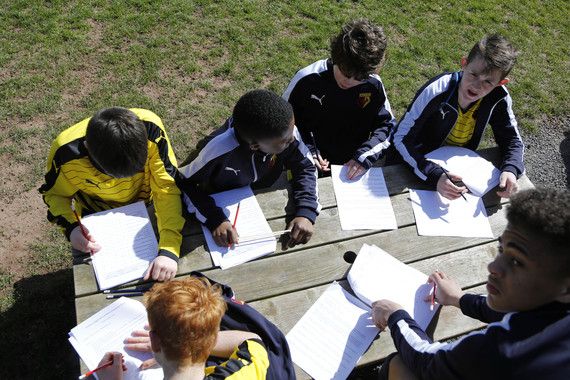Grouping kids based on physical maturity rather than simply date of birth is called bio-banding and can make late bloomers shine, and early bloomers succeed in the long run.
Even when kids are the same age they can vary greatly in size and strength, and making them compete against each other can be unfair and counterproductive at times. We spoke with James Bunce, Head of Sports Science at the Premier League and Sean Cumming, exercise scientist at the University of Bath, about a novel approach the Premier League is taking to help academies produce world class players: bio-banding.
ResearchGate: How does bio-banding work?
Sean Cumming: Bio-banding means grouping players on the basis of biological maturation which can vary greatly within age groups. Individual differences in biological maturation has implications for identifying and confirming talent, structuring competition, and the strength and conditioning of kids.
Bio-banding does not have to serve as an alternative to age group banding but can be used periodically to challenge athletes in new ways and expose them to new learning experiences, helping them develop more holistically.
RG: What are the benefits of bio-banding kids?
James Bunce: The academy system and most youth sports are dominated by early maturing players. Currently in football academies 75 percent of all players in the system are born within the first six months of the year. This is described as the relative age effect (RAE). However, when we look within elite adult professional sport this RAE dominance disappears. The Premier League first teams and England national team have fairly even distribution of birth dates.
Bio-banding is a potential scientific answer to these problems. Bio-banding allows players to be occasionally grouped based on their maturity and biological age and not upon their chronological age. By doing this you remove the violent swings in maturity that can be seen within the current chronological groupings. By grouping players based on maturity you reduce the physical advantages the early maturing players have when playing against less mature players.
This has two obvious advantages. Firstly, it allows an opportunity for the late maturing players to stop being suppressed by the physicality of the early maturers and to be able to play within a fair environment where they can thrive and develop their football ability. The advantage of this for smaller and less physical players is often the thing that gets talked about the most, however, in my opinion the second advantage is the most beneficial. The second benefit is for the early maturing players. If early maturing players become reliant on physical ability only, at a young age, they may neglect their development in other areas that are much more important, for instance technical, tactical and psychological. If the players who are the best in their groups for all of their Academy life, are dominating games and training, they may be the ones who are in biggest danger of not making it long-term. By bio-banding you take them out of an environment where they physically dominate and put them against players of similar maturity and physicality. This way all players then need to utilize and develop those other attributes to be successful.
RG: What are the disadvantages to bio-banding?
Cumming: The act of playing with new teammates and with and against players of varying age and experience presents a challenge. However, the players perceived the challenge very positively and as an opportunity to make new friends, problem solve, adopt new roles, and adapt and develop their game. A particular challenge for the coaches is how to best ascertain whether or not a child is ready to move up or down a band based on their psychological and technical skills. But by discussing this with the child, their parent, the coaches, and a sport psychologist, if available, practitioners should be able to make an informed decision. Further, if a child is struggling or not benefiting from the experience then one can simply move them back up or down.
Bunce: Also over bio-banding could have negative effects because there are advantages of players playing in miss-match situations that you don't want to remove from the system. That is why bio-banding is considered an additional method of training and most definitely not a wholesale replacement for the chronological system.
RG: What age group is especially effected by the relative age effect in soccer?
Cumming: The relative age effect can be seen in youth as young as nine years in football. Maturity associated variance in growth is greatest between the ages of 11 and 15 years in males and around ten to 14 years in females. This is when you see the most marked differences between the earliest and latest maturing children. Thus, this might be the most ideal time to implement bio-banding strategies.
RG: What do kids think about bio-banding? In what ways is it different for young soccer players to play with their physical equals when it comes to motivation and feelings of loss and success?
Cumming: Early maturing boys find it a lot tougher as they are less dominant, that said, they really appreciate this opportunity because they see it as vital in the long term development. The late maturing boys also like it as it gives them an opportunity to actually demonstrate their true ability. They are quite aware of the fact that they are delayed in maturation and realize that this counts against them in age group competitions. Of interest, both early and late maturing players reported greater feelings of self-confidence from participating in the bio-banded tournaments. The early maturing boys felt more confident to play at the next level, whereas the late maturing boys felt more confident in their ability to compete and that coaches would better realize their true potential.
Bunce: Some surprising findings were that the older players enjoyed playing with younger players as they could act as leaders and help them through situations, and conversely the younger players loved the opportunity to learn from older and different players.
Due to the work and training we had done with the clubs before the games, all of the players understood the concept of bio-banding and did not think of it as promotion or relegation into different teams but instead an opportunity to develop.
RG: In terms of kids who do well and move on to higher leagues, have you noticed a difference from bio-banding yet?
Bunce: This is a very new concept and we have only been running this within the academy system for one season and therefore have not yet seen the benefits of players moving on based on bio-banding. That being said, there are examples of the technique having a benefit. Alex Oxlade Chamberlain, currently at Arsenal, was an academy player that I worked with at Southampton. We decided to play him down an age group as he struggled to cope physically. This is not strictly the same as the bio-banding we have now developed, however, it was one of the initial successful steps in this area. Alex has spoken in the media about how the movement to the lower age group helped and supported his development. We hope bio-banding can help provide players, who could be in a similar situation, with a chance to stay at their clubs.
RG: In which other sports would bio-banding make sense?
Cumming: We are currently conducting similar research on growth and maturation in a number of additional sports, including ballet, rugby, and tennis. The work in ballet has been particularly interesting. Ballet is an art that has traditionally selected late maturing girls who are leaner, and more linear in their frame, have longer legs, and a shorter torso. That said, when we interviewed professional ballet instructors many suggested that early maturation was an advantage, which was the opposite of what we expected. When asked to explain they said that this was due to the fact that it "got the growing out of the way." When pushed more on this they explained that late maturing girls experience higher training loads and are "tested out" for professional programs at a period when they are going through their growth spurt and are more likely to be experiencing adolescent awkwardness and change in function and flexibility. This suggests to us that individual differences in growth and maturation really need to be considered in ballet, especially from a training and evaluation perspective.
RG: Why shouldn't young soccer players have to compete against physically more mature or less mature kids? People are different, sometimes to your disadvantage. Isn't that part of what you learn from playing sports?
Bunce: This is probably the question I get asked more than any other. The first thing I need to make clear is that bio-banding is an additional option for clubs. This is not and will not ever be a replacement for the current chronological age system which does elicit benefits.
We know from previous areas of research around the "underdog theory" that having a challenging or difficult environment can provide an opportunity for players to overcome the adversity of a situation and develop coping skills to do so. However, not every player has the ability to overcome this on their own and then there is the danger that a talented player could be lost due to an inability to cope physically. Also, we know that a large proportion of players mature early and often rely on their physical ability which could see their development plateau, so by bio-banding them you are actually creating a challenging environment which provides them with a new challenge they have to overcome.
If anything, the current chronological system is ironically better suited for the smaller less mature player who is consistently faced adversity and with a challenging environment. If they can overcome it then they will have developed valuable coping skills which will undoubtedly be technical, tactical and psychologically based. We want to try to create optimal challenges for everyone within the system not just a select few and thus bio-banding is one way of achieving this.
Feature image: Steve Hawkins/Premier League



